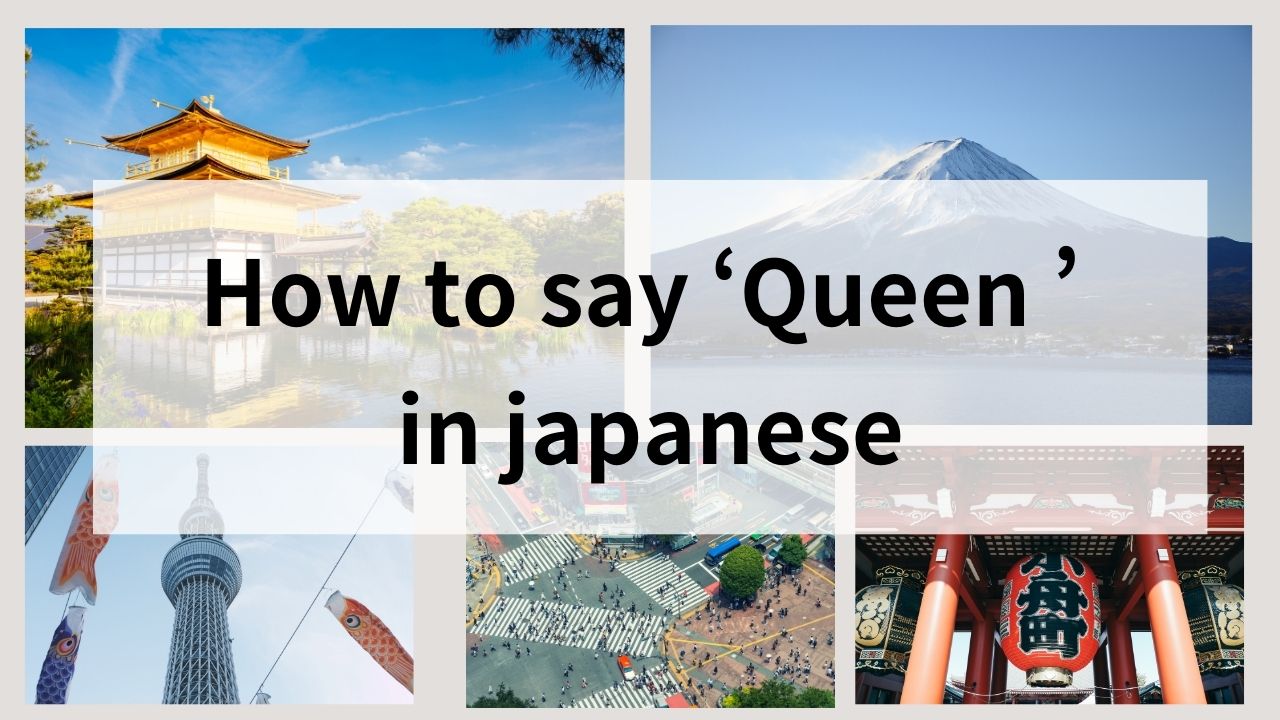Are you curious about how to say “queen” in Japanese? The word “queen” embodies notions of royalty, power, and femininity, making it a fascinating term to explore in the context of Japanese culture. This guide will delve into the Japanese word for “queen,” its cultural significance, and practical applications.
How Do You Say “Queen” in Japanese?
The Japanese word for “queen” is 女王 (ジョウオウ, joō). This term is used in both formal and informal contexts, particularly in discussions related to royalty, literature, and popular culture.
The Japanese Word for Queen: Joō (女王)
“Joō” is the direct translation of “queen,” and it appears in various phrases and contexts. For example:
- 女王陛下 (ジョウオウへいか, Joō heika): “Her Majesty the Queen.”
- 女王の宝石 (ジョウオウのほうせき, Joō no hōseki): “Queen’s jewels.”
- 女王の戦士 (ジョウオウのせんし, Joō no senshi): “Queen’s warrior.”
Kanji for Queen: 女王
The kanji for queen, 女王, literally translates to “woman” (女) and “king” (王). This combination not only denotes a female ruler but also reflects the significance of gender in the context of power. The reading for this kanji is じょおう (Joō).
Examples of phrases containing the kanji 女王 include:
- 女王国 (じょおうこく, Joōkoku): “Queen’s country.”
- 女王の玉座 (じょおうのぎょくざ, Joō no gyokuza): “Queen’s throne.”
This kanji is commonly associated with themes of royalty and leadership. Understanding these connections can help learners grasp the nuanced use of 女王 in Japanese.
Does “Queen” Work in Japanese?
The English word “queen” is generally understood in Japan, especially among younger generations or those familiar with Western culture. However, its recognition might vary among older individuals or in more traditional contexts. A 5-point scale rates its comprehension as:
- Rating: 3 – Somewhat understood (40-60% of people)
Rating Details
Understanding the 5-Point Rating for English Words in Japan
The following ratings help explain how English words are typically understood in Japan. The scale is based on context, familiarity, and the target audience.
- 5 - Universally understood (80% or more):
Words that are widely adopted into everyday Japanese, such as "coffee" (コーヒー) or "computer" (コンピューター). These words are part of the standard vocabulary and are recognized by nearly everyone. - 4 - Generally understood (60-80%):
Words that are familiar to most people but might require context for full comprehension. Examples include terms commonly used in specific industries or by younger generations. - 3 - Understood in half of the cases (40-60%):
Words that depend heavily on pronunciation or context. For example, technical terms or less common foreign words that some people may not immediately recognize. - 2 - May not be understood (20-40%):
Words that are unfamiliar to most Japanese speakers unless they have significant exposure to English or specific cultural contexts. These words are often better replaced with their Japanese equivalents. - 1 - Rarely understood (20% or less):
Highly specialized or obscure terms that are unlikely to be recognized by the general public. Clear communication requires the use of Japanese vocabulary or additional explanation.
This rating system provides a practical guide for determining when and how to use English words effectively in Japan. Understanding the audience and context is key to ensuring clear communication.
If clarity is crucial, using the Japanese term 女王 (Joō) is recommended. While “queen” may be understood in certain contexts, “joō” ensures effective communication.
The Cultural Significance of Queens in Japan
The concept of a queen has evolved in Japan’s cultural landscape, symbolizing authority, grace, and femininity. Although Japan does not have a reigning queen in the same manner as Western monarchies, the idea of a queen retains cultural significance, often represented in literature, media, and traditional practices.
Queens in Historical Context
In ancient Japan, the role of women in leadership was often relegated to mythological or legendary figures. Queens, such as Empress Jingu, are celebrated in history, embodying strength and wisdom. While modern Japan is a constitutional monarchy with a male emperor, the notion of a queen still resonates through cultural narratives.
Queens in Japanese Folklore and Literature
Queens and female rulers also appear in Japanese folklore and literature, often symbolizing power and beauty. They serve as archetypes of the ideal woman, embodying both strength and grace.
In modern Japanese pop culture, queens are often depicted in anime, manga, and video games, reflecting contemporary interpretations of feminine power. This connection emphasizes the enduring nature of the queen archetype in Japanese society.
- Dragon Ball: The character Queen Serenity is portrayed as a wise and powerful figure, representing strength and compassion.
- Fate/Grand Order: Various characters embody the role of queen, showcasing different aspects of leadership and femininity.
- Final Fantasy: The series often features queen characters with complex narratives, highlighting their power and influence in the game’s lore.
These examples demonstrate how the concept of a queen continues to represent strength, wisdom, and femininity, bridging traditional folklore and modern storytelling.
Differences Between Queens in Japan and Overseas
Yes, there can be subtle differences in how “queen” is perceived in Japan compared to Western cultures. In Japan, the term 女王 (joō) often carries historical connotations of nobility and myth, while in Western contexts, “queen” may be more associated with contemporary royal figures and public personalities. Understanding these cultural nuances can help avoid confusion, especially when discussing themes of power and femininity.
Practical Applications of “Queen” in Japanese
Learning how “queen” is used in Japanese can help you navigate conversations, understand idioms, and recognize its presence in Japanese culture.
Talking About Queens in Daily Conversation
Here are some examples of how “joō” is used in everyday conversation:
- 女王が好きです (Joō ga suki desu): “I like queens.”
- 女王の物語 (Joō no monogatari): “The story of the queen.”
Queen-Related Idioms or Expressions
While there are relatively few specific idioms involving “joō,” the term is often associated with power, beauty, and leadership in Japanese culture. Here are some idioms, phrases, and expressions that incorporate or symbolize queens:
- 女王のように (Joō no yō ni): “Like a queen,” symbolizing grace and authority.
- 女王の心 (Joō no kokoro): “Queen’s heart,” representing compassion and strength.
- 女王の道 (Joō no michi): “Queen’s path,” referring to a journey of leadership and courage.
These idioms and expressions reflect the deep cultural and aesthetic appreciation of queens in Japan, often tied to themes of power, beauty, and femininity. By learning these phrases, you can gain a deeper understanding of how queens are interwoven with Japanese language and values.
Queens in Japanese Cuisine or Products
While the term “queen” may not directly relate to cuisine, the concept of queens is often celebrated in Japanese culture and events, such as festivals and ceremonies, showcasing their aesthetic appeal and cultural significance. Here are some notable examples:
- Queen Cake (クイーンケーキ, Kuīn kēki): A popular dessert often enjoyed during celebrations, symbolizing sweetness and joy.
- Queen Crab (クイーンカニ, Kuīn kani): A delicacy that is highly prized for its flavor and texture, often associated with nobility in dining.
These examples highlight how the concept of a queen is not only culturally significant but also celebrated through food and culinary traditions in Japan.
FAQs
Here are some frequently asked questions about queens in Japanese culture and language.
Is “Queen” a Popular Concept in Japan?
Yes, the concept of a queen is popular in Japan, often associated with beauty, grace, and power. It is frequently referenced in literature, media, and art.
How Do You Write “Queen” in Japanese?
The word “queen” can be written in different scripts in Japanese: hiragana and kanji. Each script serves different purposes depending on the context and formality. Here’s a breakdown:
- Hiragana (じょおう, Joō):
Hiragana is commonly used for “queen” in casual writing or when teaching children. It is simple and easy to read, making it ideal for everyday use. - Katakana (クイーン, Kuīn):
Katakana may appear in stylistic contexts, such as advertisements or product names, often used to emphasize the term. - Kanji (女王, Joō):
Kanji is the most formal and traditional way to write “queen,” often used in literature and cultural contexts. It conveys a sense of elegance and authority.
Choosing which script to use depends on the tone, audience, and purpose of your communication. Understanding these variations can enhance both your written and spoken Japanese skills.
Conclusion
The term “queen,” or “女王 (joō)” in Japanese, symbolizes femininity, power, and cultural significance. By understanding its role in Japanese language and traditions, you can deepen your appreciation for this concept and its place in Japanese society.








